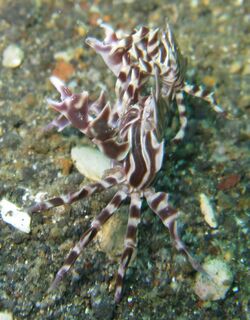Biology:Zebrida adamsii
| Zebrida adamsii | |
|---|---|

| |
| Scientific classification | |
| Domain: | Eukaryota |
| Kingdom: | Animalia |
| Phylum: | Arthropoda |
| Class: | Malacostraca |
| Order: | Decapoda |
| Suborder: | Pleocyemata |
| Infraorder: | Brachyura |
| Superfamily: | Pilumnoidea |
| Family: | Pilumnidae |
| Subfamily: | Eumedoninae |
| Genus: | Zebrida |
| Species: | Z. adamsii
|
| Binomial name | |
| Zebrida adamsii White, 1847[1]
| |
| Synonyms[1] | |
| |
Zebrida adamsii is a distinctively striped species of crab that lives in association with a sea urchin in the Indo-Pacific region. It is cryptically coloured with vertical stripes and has special adaptations to its legs to enable it to cling to its host's spines.
Description
Z. adamsii is a small crab, described as "a torpid, though elegant little crustacean" by the English naturalist Arthur Adams when it was first discovered by him and the Scottish zoologist Adam White during the surveying voyage of HMS Samarang in the Far East between 1843 and 1846. The carapace and limbs are smooth and hairless and are adorned with long spines. The colour is pink with dark, reddish-brown vertical stripes.[2][3]
Distribution
Z. adamsii has a wide distribution in shallow water in the tropical Indian Ocean and western Pacific Ocean.[3] The type locality is the estuary of the Pantai River in Borneo at a depth of about 35 ft (11 m).[2]
Ecology
Z. adamsii lives in symbiosis with a sea urchin, living among its spines.[4] Sea urchins on which it has been found include Asthenosoma ijimai, Diadema setosum, Heliocidaris crassispina, Pseudocentrotus depressus, Salmacis bicolor, Salmacis virgulata, Toxopneustes elegans, Toxopneustes pileolus, Tripneustes gratilla and a species of Acanthocidaris.[3] Adaptations for this lifestyle include a specialist joint between the propodus and dactylus on the walking legs enabling the crab to cling to its host, and cryptic colouring in the form of vertical stripes. Females are slightly larger than males and usually live singly on a sea urchin while males move from one urchin to another searching for females.[4]
Z. adamsii feeds on its host's tube feet and on the epidermal tissue covering the test and the base of the spines. This does little harm to the host which readily regenerates both the tissue and the tube feet.[4]
Z. adamsii larvae are planktonic and pass through four zoeal stages, and one megalopa stage before settling on the seabed and undergoing metamorphosis into juvenile crabs.[5]
References
- ↑ 1.0 1.1 Davie, Peter (2018). "Zebrida adamsii White, 1847". WoRMS. World Register of Marine Species. http://www.marinespecies.org/aphia.php?p=taxdetails&id=442390.
- ↑ 2.0 2.1 Arthur Adams (1848). "Loo-Choo–Korea–Japan". in Edward Belcher. Narrative of the voyage of H.M.S. Samarang, during the years 1843–46: employed surveying the islands of the Eastern archipelago; accompanied by a brief vocabulary of the principal languages. 2. Reeve, Benham, and Reeve. https://books.google.com/books?id=zjYNAAAAIAAJ&pg=PA497.
- ↑ 3.0 3.1 3.2 Ng, Peter K.L.; Chia, Diana G.B. (1999). "Revision of the genus Zebrida White, 1847 (Crustacea: Decapoda: Brachyura: Eumedonidae)". Bulletin of Marine Science 65 (2): 481–495. http://www.ingentaconnect.com/content/umrsmas/bullmar/1999/00000065/00000002/art00013.
- ↑ 4.0 4.1 4.2 Castro, Peter; Davie, Peter; Guinot, Danièle; Schram, Frederick; von Vaupel Klein, Carel (2015). Treatise on Zoology: Anatomy, Taxonomy, Biology. The Crustacea, Volume 9 Part C (2 vols): Brachyura. Brill. pp. 549–552. ISBN 978-90-04-19083-2. https://books.google.com/books?id=g6a9CwAAQBAJ&pg=PA549.
- ↑ Mori, Atsushi; Yanagisawa, Yasunobu; Fukuda, Yasushi; Ng, Peter K.L. (1991). "Complete larval development of Zebrida adamsii White, 1847 (Decapoda: Brachyura), reared in the laboratory". Journal of Crustacean Biology 11 (2): 292–304. doi:10.2307/1548366.
External links
- Photos of Zebrida adamsii on Sealife Collection
Wikidata ☰ Q7938094 entry
 |

